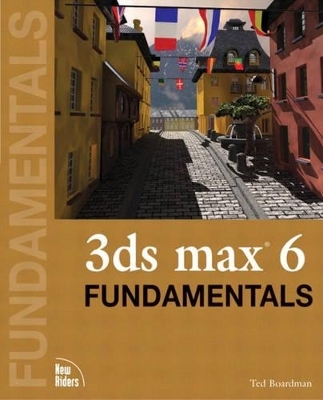
3ds max 6 Fundamentals
New Riders Publishing
978-0-7357-1385-7 (ISBN)
- Titel ist leider vergriffen;
keine Neuauflage - Artikel merken
For the new user or seasoned pro, Discreet authorized trainer, Ted Boardman, explains the latest version of the most popular 3d program. Following the exercises and tutorials in the book, readers will discover the new features of 3ds max 6 that make it even more powerful and easier to use. Learn how to work effectively and efficiently through production techniques covered in this book.
Leading 3ds max trainer Ted Boardman covers every core technique and skill for making the most of 3ds max 6 in virtually any application or industry, including computer/video games, web content development, film, television, and architecture. Boardman begins by introducing the fundamental concepts students need to work with 3ds max 6. Next, he introduces the fundamentals of modeling, applying materials and maps, applying realistic lighting, and effectively integrating animation. Then, he focuses on interior scenes, introducing 3ds max modeling techniques for radiosity and efficiency; more sophisticated approaches to materials and mapping; and the software's powerful animation controllers. Coverage also includes freeform lighting, animating in world space, adding realistic dynamics with reactor, and video post-production.
Currently, Ted Boardman is a traveling Discreet 3ds max and Autodesk 3D Studio VIZ training consultant. Ted is one of a handful of Authorized Discreet Training Specialists. Training sessions are custom classes designed to increase 3D modeling and animation productivity for a wide range of clients, from architecture, to aerospace, to television and computer gaming. An integral part of Ted's training process is authoring and co-authoring books for New Riders Publishing on the production issues encountered in using 3ds max, including 3ds max 4 Fundamentals, several books from the Inside 3D Studio MAX series, and Inside 3D Studio VIZ 3. Ted has contributed to several other books on the subject, as well as to Discreet advanced modules, and currently has a monthly column covering topics related to 3ds max at the http://www.cgarchitect.com web site. Ted is an award-winning speaker at the annual Autodesk University symposium covering CAD and visualization topics and is founder of the Boston Area 3D Studio User Group. Outside the 3D world, Ted has traveled, lived, and worked in Europe for many years, and for nearly 18 years ran a small architectural design/build firm that specialized in hand-cut Post and Beam structures. Long-distance bicycle travel and 28,000 miles of blue-water yacht deliveries served as a diversion from work for many years. Photography, painting, and opera are other interests. Ted lives in Portsmouth, New Hampshire.
Introduction.
I. INTRODUCTION.
1. Workflow: Keeping the Process Running Smoothly.
In This Chapter. Key Term. Preparation and Planning. Execution. Integration and Output. Summary.
2. Important Fundamental Concepts in 3ds max 6.
In This Chapter. Key Terms. Coordinate Systems in 3ds max 6. Summary. Layers. Settings and Startup Configuration. Lofting Basic Concepts. Summary.
II. OUTDOOR SCENE WITH SHIP.
3. Fundamental Modeling Techniques: The Building Blocks.
In This Chapter. Key Terms. Standardizing Your Display Space. 2D ShapesA Foundation of Efficient Modeling. 2D Shape Sub-Object EditingPractical Applications. Modifiers and the Modify Stack. Alignment Tools and Grids. Summary.
4. Shipbuilding 101: The Making of a Boat.
In This Chapter. Key Terms. Primitive Objects and Editable Poly: A Starting Point. Box Modeling from a Background Image. Building Superstructure with New Modifiers. The Lathe and Shell Modifiers. Spacing Tool and Renderable Splines. Merging Objects from Other 3ds max Files. Summary.
5. Creating Convincing Terrain.
In This Chapter. Key Terms. Tracing Contour Maps to Create 3D Terrain: The Process. Creating the Terrain, Water, and Sky. Creating Low-Polygon Trees. Building a Scene in a Collaborative Environment. Cutting a Boat Ramp into Terrain. Summary.
6. Fundamental Outdoor Lighting with Standard Lights.
In This Chapter. Key Terms. The Sunlight System. Adding Fill Lights to Simulate Bounced Light. Shadow Optimization. Lighting the Skydome. Summary.
7. Introduction to Materials and Mapping.
In This Chapter. Key Terms. The Material Editor. Materials with Procedural Maps as Patterns. Material Libraries to Store Materials. Summary.
8. The Fundamentals of Scanline Rendering.
In This Chapter. Key Terms. The Renderers. The Rendering Process. Network Rendering. Summary.
III. INTERIOR OF SHIPS BRIDGE.
9. Diving Deeper into Modeling Techniques.
In This Chapter. Key Terms. Command Center Honeycomb Walls. A Modeling Technique Called Lofting. Summary.
10. Modeling with Patch Surfaces.
In This Chapter. Key Terms. Organic Modeling with Spline Cages and Patch Surfaces. Editing the Patch Surface. Summary.
11. Materials and Mapping: A Different Approach.
In This Chapter. Key Terms. Real-World Mapping Coordinates. Multiple Materials on Single Objects. Working with Shaders to Control Specular Highlights. Other Productive Material Attributes. Summary.
12. Photometric Lighting: Bounced Light Calculation.
In This Chapter. Key Terms. Photometric Lights. Meshing Parameters for a Better Radiosity Solution. Modeling Issues with Radiosity Renderings. Summary.
13. Radiosity Rendering: Material Control.
In This Chapter. Key Terms. Material Issues with Radiosity Rendering. Exposure Control Options. Summary.
IV. SETTING THINGS IN MOTION.
14. Set Key Animation.
In This Chapter. Key Terms. Hierarchical Linking and Dummy Objects. Summary.
15. Controllers/Constraints.
In This Chapter. Key Terms. Summary.
16. Graph Editors.
In This Chapter. Key Terms. Graph Editors. Summary.
V. SPECIAL EFFECTS.
17. Reactor.
In This Chapter. Key Terms. Reactor. Summary.
18. PFlow.
In This Chapter. Key Terms. PFlowThe Powerful New Particle System. Summary.
Index.
| Erscheint lt. Verlag | 5.2.2004 |
|---|---|
| Sprache | englisch |
| Maße | 231 x 185 mm |
| Gewicht | 885 g |
| Themenwelt | Informatik ► Grafik / Design ► Film- / Video-Bearbeitung |
| ISBN-10 | 0-7357-1385-5 / 0735713855 |
| ISBN-13 | 978-0-7357-1385-7 / 9780735713857 |
| Zustand | Neuware |
| Informationen gemäß Produktsicherheitsverordnung (GPSR) | |
| Haben Sie eine Frage zum Produkt? |